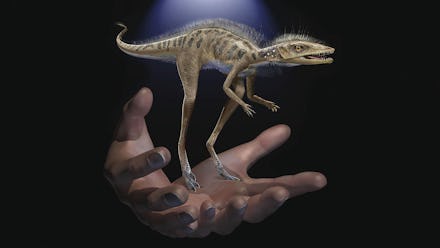Scientists just discovered a dinosaur ancestor that was so small you could hold it in one hand

A group of paleontologists have identified the remains of a tiny creature from Madagascar called Kongonaphon kely, also known as the 'tiny bug slayer,' in a study published Monday in the Proceedings of the Natural Academy of Sciences. This small beast measured four inches tall and had little, serrated teeth, implying it feasted on prehistoric, hard-shelled insects. It was so small it could have fit in your hands or, if you were feeling particularly adorable, your pocket. While that sounds cute, it doesn't exactly seem intimidating — which is why researchers were surprised to find that this creature was an ancestor of the giant dinosaurs we've come to know and love.
"There's a general perception of dinosaurs as being giants," said lead author Christian Kammerer in a statement. "But this new animal is very close to the divergence of dinosaurs and pterosaurs, and it's shockingly small."
The fossils of K. kely date back to about 237 million years ago, during the Late Triassic period, which was just before enormous dinosaurs ruled the Earth. Researchers found these bones back in 1998, but haven't been able to take a good look at them until now.
"It took some time before we could focus on these bones," paleontologist and co-author John Flynn admitted in a press release, "but once we did, it was clear we had something unique and worth a closer look."
The closer look involved an analysis of the femur and other remains, making sure the small bones weren't from multiple species or a juvenile creature. Then, the researchers tried to place the bug slayer on an evolutionary tree based on the evidence and data they gained from the fossils. This placed K. kely in the Ornithodira group, a category of species that are theorized to be the last common ancestors between dinosaurs and pterosaurs. K. kely isn't the first common ancestor to be found, but its discovery lends evidence to the idea that dinosaurs started out smaller before becoming bigger.
"Recent discoveries like Kongonaphon have given us a much better understanding of the early evolution of ornithodirans," stated lead author Chrisian Kammerer. "Analyzing changes in body size [...] we found compelling evidence that it decreased sharply early in the history of the dinosaur-pterosaur lineage."
This was referred to as a "miniaturization" event in the study. The researchers believe that an event like this — one that resulted in a small-sized creature like K. kely — could explain how dinosaurs and pterosaurs got their fuzz and how pterosaurs could eventually develop a body meant for flight. Eating insects could've also helped the little dino ancestor survive until it moved into different ecological niches, where its descendants adapted to flight or became larger meat-eaters.
The discovery of K. kely could fill in the blanks that have puzzled paleontologists with regard to dinosaur evolution for decades. "Although body size evolution has been studied extensively within Dinosauria," wrote the team, "the lineage leading to dinosaurs has received less attention." This is because "[early] members of the dinosaur-pterosaur clade Ornithodira are very rare in the fossil record, obscuring our understanding of the origins of this important group."
Despite the rarity of these fossils, the research team wrote that they believe "ornithodirans may have been substantially more abundant in their ecosystems than the known record indicates" and called for more field research into paleontological sites containing samples from the Triassic era.
"This fossil site in southwestern Madagascar, from a poorly known time interval, has produced some amazing fossils," stated Flynn, "and this tiny specimen was jumbled in among the hundreds we've collected from the site over the years. [...] This is a great case for why field discoveries — combined with modern technology to analyze the fossils recovered — is still so important."